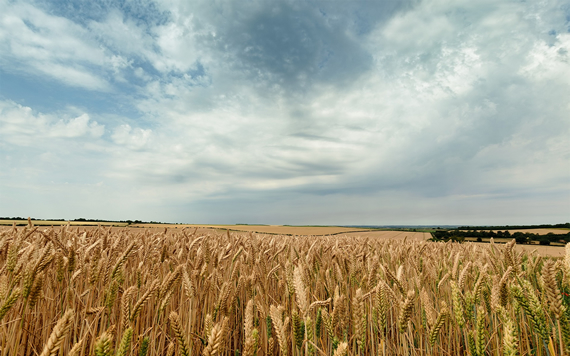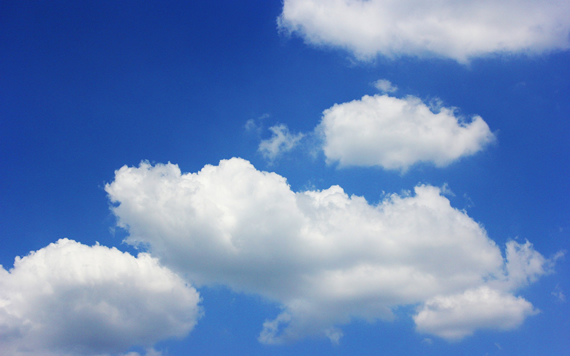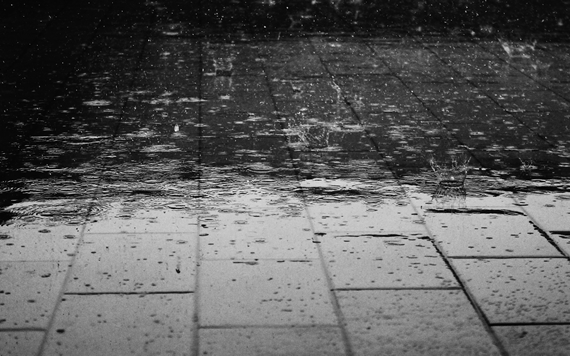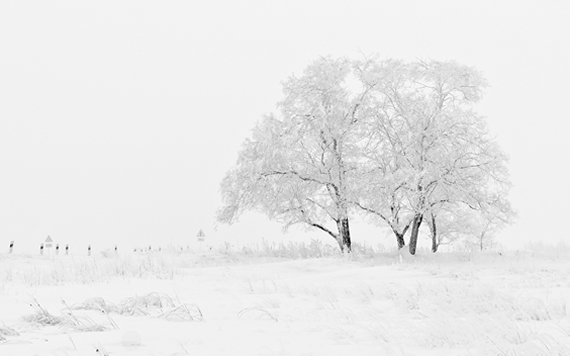Climate in Bourne
Bourne has a temperate climate with four distant seasons and temperatures that are rarely extreme but can change dramatically. Our climate is generally wet and mild but is hugely variable.
Like the rest of the UK, Bourne is influenced by a number of different air masses, these being the maritime polar air mass (from the north), continental polar air mass (from the east), continental tropical air mass (from the south) and the maritime tropical air mass (from the west). This results in a varied and often unpredictable climate. Usually, however, Bourne is most influenced by the maritime tropical air mass from the Atlantic, driven by a fast ribbon of air high up in the atmosphere known as the jet stream (essentially the boundary between warm tropical air in the south and colder artic air in the north), which drives warmer air from the Gulf of Mexico to the UK across the Atlantic Ocean, along with weather fronts. This means Bourne is sometimes susceptible to fast-moving low-pressure systems, contributing to wet and overcast conditions, and keeping temperatures mild in the winter - much more so than what would normally be expected considering the latitude, which is on par with southern Canada. Due to its south-easterly position, during the summer when the jet stream often weakens and moves further north, Bourne is more susceptible to the tropical air masses from the near continent, often resulting in warm, dry conditions for the town. The dominating air mass can greatly affect the range of temperatures and general weather conditions, and this is why it is so difficult to predict the general pattern of weather for any particular time of year.
As a rule, the jet stream heavily influences our weather patterns - if it's directly over us, which is more likely over the autumn and winter months, then the weather is often unsettled and wet (but often mild). If it is to the north of us our weather will often be settled and warm (as we will be in the warmer air mass), and if it's to the south of us our weather will often be settled and cool (as we will be in the cooler air mass).
wb_sunnywb_cloudyac_unitflash_onbeach_access
Spring in Bourne (March - June)
The start of spring in Bourne is 20th March (in astronomical terms), and it's at this time of year that as the daylight increases and temperatures begin to rise, the trees and flowers begin to bud and the lush green countryside that Bourne and the rest of Lincolnshire is renowned for, comes back to life. It's certainly a pretty time in Bourne as trees begin to blossom and the rapeseed grown in surrounding fields starts to bloom with bright yellow flowers.
Spring is very much a period of transition and so the weather is often changeable, with some days still feeling wintry and other days being warm and sunny. As a general trend, early spring tends to begin on the rather cool side, with an average high temperature of around 10℃ in March - although as the sun becomes stronger and the amount of daylight increases day-by-day, sunny days can feel rather pleasant. Night time temperatures during early spring can, however, still drop well into single figures and this can result in some overnight frosts. Some minimal snowfall has also been known during early spring, but it is very unlikely that the snow will settle.
As the season progresses, temperatures really start to warm up nicely, with an average high of around 14℃ in April, slowly climbing to an average high of around 16℃ to 18℃ during May. At this time of year, the days become much longer than the nights, with the sun not setting until well into the evening and rising in the early hours of the morning. The sun is also strong at this time of year, so any sunny days can feel rather warm, even hot on occasions. Late April/early May is perhaps one of the prettiest time of year in Bourne as the common Hawthorn tree gives its beautiful display of flowers - the blossom itself being called May.
The most common weather trend during spring is sunshine and showers, especially during April - hence why the weather in April is often referred to as April showers. As the season progresses, however, the showery conditions do tend to subside and sunshine becomes more of a prominent feature - the month of May, for example, can see long periods of dry, settled conditions. There is, however, an old saying that is still cast around during late spring, 'Ne'er cast a clout till May be out' - this simply means don't take your warm clothes off until the May blossom is out because cold weather can return during the spring months.

Summer in Bourne (June - September)
The warmest mouths tend to be June, July and August were the average high temperature typically ranges between 18℃ to 22℃. The warmest period will generally be experienced in late July and early August were the town is likely to see average high temperatures of a very pleasant 22 to 23℃. On occasions temperatures do peek into the upper twenties, but rarely reach above 30℃ (a temperature of 30℃ or more is likely to be recorded on around two days each summer). Bourne tends to experience the highest temperatures during settled spells when the wind direction is from a southerly direction as this pulls up warm or hot air from places such as Spain, Africa and the Azores. As a rule, Bourne has a pleasant climate during summer, with temperatures rarely reaching levels that would be considered too hot. It can, however, be humid in the summer and so at times it can be sticky and uncomfortable - this makes it particularly difficult to sleep at night as most homes in Bourne do not have the benefit of air conditioning.
There are usually plenty of warm and sunny days to be had during the summer months, and certainly during dry settled periods, it's not uncommon for temperatures to hover into the mid to late twenties for concurrent days. Good weather during summer can never be guaranteed, however, and as a general rule the hot sunny conditions that we normally associate with summer will be periodic, being interspersed with cooler more unsettled conditions.
The sun reaches its highest point in the sky during the end of June (the Summer Solstice is on the 21st June) and so at this time of year the days are at their longest in Bourne. In late June, for example, it doesn't get completely dark until gone 10.00pm and is light again by 5.00am. The long days during summer make this the time of year when many outdoor events take place in Bourne and the surrounding villages. On a warm sunny day, you'll see many people out and about enjoying the many green spaces around the town, and cooling off in the large outdoor swimming pool.
The sun is at its strongest this time of year so it's important to remember to apply sun protection when out and about, particularly if you are out in the sun from midday until 3.00pm when the sun is at its highest point in the sky. Many people underestimate just how strong the sun can be in British summer time, leading to sunburn and sunstroke.
The summer of 2018 was a record breaker across Bourne were high pressure was sustained for nearly the whole period from early May until late July, leading to some very high temperatures and consistent days of sunshine. There was also very little rain fall during this period meaning that much of the grass around Bourne turned completely brown - a sight rarely seen in the town. This summer will certainly be remembered as one of the warmest and driest on record.

Autumn in Bourne (September - December)
September the 22nd marks the first day of autumn in Bourne (in astronomical terms) and as we head into this stage of the year the days become shorter and leaves begin to fall off the trees. Late September still sees an average high of around 18℃, and certainly in early Autumn it can feel pleasant, with the sun still high enough in the sky to feel warm. There is often, however, a chill in the air during early mornings and nights, and it's at this time of year that a jacket may become necessary when venturing out.
Autumn is generally a wet and windy time in Bourne as the town tends to see more weather fronts being introduced from the Atlantic Ocean due to a strong jet stream that tends to position itself over the UK at this time of year. Gale force winds and heavy rain become a common feature in Autumn, and it is likely that the town will see the odd storm during this period.
The clocks go back an hour at the end of October and it's at this stage in autumn that temperatures really start to drop away as the nights become much longer than the days. By this stage the trees have lost the majority of there leaves and fog and frost begin to become more commonplace - late autumn sees an average high of just 8℃. It's also not unheard of for there to be a minimal amount of snow at the end of the season, although this is quite rare.

Winter in Bourne (December - March)
The coldest months tend to be December, January and February, were temperatures typically peak at around 5 - 8℃ (although the wind chill can often make it feel far colder than this) during the day and frosts become common overnight. You'll certainly need to wrap up warm if you're venturing outdoors at this time of year! Despite the northerly latitude of Bourne, winters are, however, generally quite mild, with temperatures rarely dropping below 0℃ during the day, and snow fall normally minimal - usually Bourne gets no more than a light covering of snow and this is most likely to occur from mid-January to the beginning of March. On occasions, however, when the predominate south-westerly maritime air mass becomes blocked, Bourne does experience periods of very cold weather during winter, were more substantial snow fall and freezing temperatures may be experienced. This was apparent in the winters of 2010/2011 and 2011/2012, were several weeks of sustained freezing temperatures, significant snow fall, and widespread ice were experienced in Bourne due to much colder air being imported in from the east. The late winter of 2018 saw the heaviest snow fall in many years in Bourne, with the snow being substantial enough to close many roads, schools and businesses in the town. Generally speaking, if the wind is coming from a northerly or easterly direction then it will feel bitter in Bourne at this time of year.
The number of rainy days during winter tends to be more than the rest of the year and there can be concurrent days of grey days to contend with, however, the sun does still make an appearance at this time of year and there can be some lovely crisp sunny days. Sunny days, however, tend to give-way to clear nights and this is when the temperature can drop well into single figures, sometimes leading to freezing temperatures.
Daylight hours during the winter months are short - on average Bourne sees just eight hours of daylight in the winter months with darkness setting in as early as 4.00pm in December. After the shortest day on December 21st, however, daylight hours do then start to increase and by February the increasing daylight certainly becomes more noticeable - a sure sign that spring is just around the corner.
Does it snow at Christmas in Bourne?
December marks the start of winter in Bourne and indeed the rest of England so there's a good chance it will be cold at Christmas, but it’s quite rare for Bourne to see any snow around Christmas. Statistically, there's more chance of seeing snow in March than at Christmas in Bourne. This is backed by The Met Office who report that it has snowed for more days on average in March than it has December in England as a whole.

General Information
Rain in Bourne is generally distributed evenly through-out the year, with a slight increase during the autumn and winter months (peaking in October) - it will generally rain on average for half the days in each month - although this may be in the form of showers and it will generally not rain all day (although this cannot be ruled out!). Due to Bourne's location in the south east of the country, however, rainfall tends to be less than that of other parts of the UK as it further away from the influences of the low pressure systems that are brought in from the Atlantic Ocean - most of these tend to have fizzled out or at least lost a lot of their moisture by the time they reach Bourne. In fact, it is not uncommon, certainly in the summer months, for Bourne to experience dry periods with little rainfall. The south east of the country is also thought to receive the most amount of sunshine and this is reflected in Bourne, with periods of sunny conditions not uncommon.
Extreme weather such as tornados, hurricanes, floods and droughts are virtually unheard of in Bourne, but there have been a few occasions in history were such events have been recorded. Due to the flat terrain around Bourne, the town is sometimes subject to strong winds, especially during the autumn.
If you're planning on visiting Bourne, the advice is to prepare for all kinds of weather - no matter what time of year you're here. Due to the instability of the weather here, it is very rare that one type of weather pattern will prevail for more than a week at a time and some weeks it's possible to experience several different types of weather and variation of temperatures - one day it can be sunny and warm and the next it can be raining and chilly. High pressure does sometimes dominate our weather but even then a subtle shift in the position of this can lead to a considerable drop or increase in the temperature and cloud cover.
As a general rule, if you're visiting Bourne in the summer, it should be warm enough to wear a t-shirt most days (maybe even shorts!) - but it's also recommended to keep a jacket to hand as rain is still fairly common at this time of the year. It's also recommended to keep a jumper handy for the evenings and overnight as even in the height of summer, it can still feel a little chilly in the evening and overnight. In winter, warm clothing and a thick coat is recommended to protect against the cold and wet - although there may be some days during sunnier and settled spells were a jumper should suffice. In spring and autumn, you may need clothing to suit all weathers - some days it may be warm and dry enough to wear just a t-shirt, whereas other days you may find yourself wanting to wrap up warm in a nice thick coat. Obviously though this will depend somewhat on what stage of the season we are at - early spring, for example, is almost certain to still be on the chilly side!
With climate change taking effect it is expected that Bourne may experience more extreme weather in the future, which could result in more prolonged hot spells during summer and much colder weather in winter. 2018 certainly seemed to fit this trend with a particularly cold and harsh winter, followed by a long hot summer.
Daylight Savings Time
Like the rest of the UK, Daylight Savings Time takes place in Bourne. This is the practice of setting the clocks forward one hour from standard time during the summer months, and back again in the autumn, in order to make better use of natural daylight. Clocks will normally go forward an hour in the last weekend of March (known as British Summer Time) and back an hour the last weekend of October.
Weather Averages in Bourne




